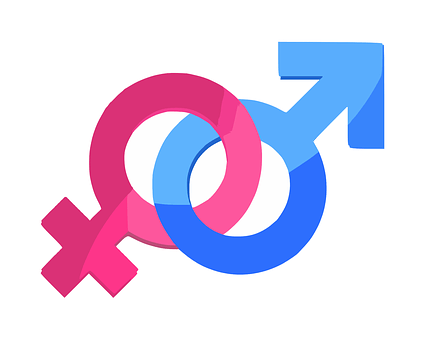In some languages it is common for men and women to use different lexical items to mean the same thing. Language and gender are deeply and ostensibly intertwined. So two words that effectively refer to the same idea or object are selected by the speaker based on their gender.
Language and Gender
Recently, the topic of gender has become a talking point, generally around the ideas of expected gender roles and norms, and how they differ. The idea of gender roles has played a part in society for centuries – so much so, that it can even be seen in certain languages and the way people speak.
The Japanese language is one such example where language and gender influence one another. All of the nouns meant to be used by female speakers begin with /o-/, which is an honorific prefix used in polite speech.
| Men’s Form | Women’s Form | English Translation |
| hara | onaka | stomach |
| tukemono | okookoo | pickles |
| mizu | ohiya | water |
| bentoo | obentoo | box lunch |
| kane | okane | money |
| hasi | ohasi | chopsticks |
| umai | oisii | delicious |
| kuu | taberu | eat |
| kutabaru/sinu | nakanaru | die |
Language and gender relationships can also be found in some Native American languages, where verb inflection can vary based on the speaker’s gender. In language communities where gender roles are rigid, this type of influence gender has on language is common. However, in societies where they are less clearly defined or are facing backlash, studies of gender differences show trends instead of hard facts. Even in Japan—a society with traditionally clear gender roles—is experiencing a difference in language use by generations with younger women not adhering to the prescribed forms of nouns shown in the table above.
Gender Neutral Words?

Gender Neutral Pronouns
Languages like German have masculine, feminine, and neuter third-person pronouns, or ones that are genderless. In English, there may only be a masculine and feminine singular pronoun. Recently, in cases where a person’s gender is not a necessary contributor to the meaning of an expression, many English speakers have been using the plural form, they, to refer to an individual of undisclosed gender. Although this faced backlash from academics and professional writers, it is now commonly seen in professional publications without being perceived as a grammatical error. Efforts have been made by LGBT advocates to introduce an entirely new set of singular gender-neutral pronouns, ze and zir, particularly for those who do not adhere to the prescribed two-gender system.
Patterns of Language Use Emerging Along Gender Lines
The above descriptions of gender differences focused on the prescribed forms of language referring to gender. However in English and other languages belonging to societies where the roles of men and women are not mutually exclusive, many of the differences between male and female language are seen in the way different genders tend to use their shared language. Two general theories have been offered to account for these discrepancies:
Difference theories
This class of theories about language and gender is centered on the idea that men and women belong to different cultural worlds, which in turn contribute to the emergence of different linguistic characteristics.
Dominance theories
This theoretical framework relies on the idea that men and women inhabit the same cultural world, but the distribution of power is unequal. Language and gender differences that arise reflect the contrast in status and goals between the two groups.
Examples of differences in the English spoken in the U.S. include an observed tendency of women to speak less in public and interject in public settings much less often. Articles about how to remove traditionally feminine linguistic markers (e.g. apologizing, passive language, tagged questions, and qualifying language) have been populating the internet for the past few years. The merits of erasing these feminine markers to create more “acceptable” speech—the kind currently associated with men—are still debated, as the markers may simply represent a difference in language usage, not a deeper relation between gender and language.
The Impact of Language and Gender on Translators
The complications presented by the interaction between language and gender are of the utmost importance to professional interpretation and translation services providers. Understanding culture and gender rules for both the source language and target language is required for an accurate and culturally sensitive final product. Going between languages with different gender rules may also require a translation technique known as compensation. This practice involves placing information that is impossible to incorporate into the target language elsewhere in the text, as would happen if a translator explicitly indicates the gender of a Japanese speaker in an English translation after they extract the gender from the noun form in the Japanese text.
Sources:
- http://www.ucc.ie/publications/heeu/womenstf/3_conrick.htm
- http://languagelog.ldc.upenn.edu/myl/ldc/ling001/gender.htm
- Roy Sorensen, Washington University professor of philosophy
About Language Connections:
Language Connections is one of the top language service companies in the US. Over the last 30 years, we’ve focused on providing the best business translation services, interpreting services, as well as interpreter training and customized language training programs. In addition to top-tier corporate language training, we offer certified corporate interpreters and professional business translation services in 200+ languages. Our network includes linguists with backgrounds in all major industries. They’re ready to meet your needs, whether they’re for technical translation services, legal translation, government translation services, international development translation services, education translation services, life sciences translation, or something else. Reach out to us today for a free quote on our cost-efficient and timely translation services, interpreters, or other linguistic services.
Language Connections Inc.
2001 Beacon Street, Suite 105,
Boston, MA 02135
Phone: +1-617-731-3510
Email: service@languageconnections.com


